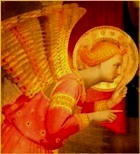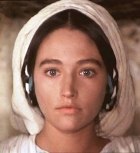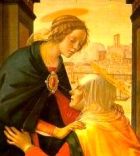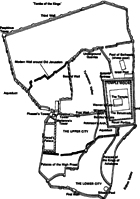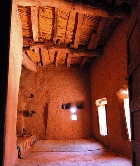Jesus is born in Bethlehem
Questions for Bible study groups
- Why was the betrothal of Mary & Joseph more binding than a modern engagement?
- Why were Mary & Joseph in Bethlehem, not Nazareth?
- Who chose the name ‘Jesus’?
- When was Jesus born?
Tiny, red and wrinkled, the newborn baby Jesus lay on a pile of hay – the Prince of Peace in a stable. It is a story of love and hope.
Joseph’s dream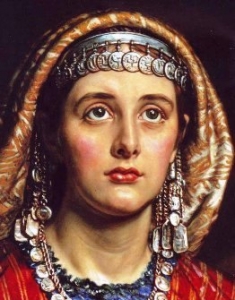
Joseph and Mary were betrothed to be married. This was a binding relationship, more so than a modern engagement, because it involved not only a promise between two people but the exchange of money and goods.
It was a prenuptial contract made in front of witnesses, only broken by a formal process of divorce. Unfaithfulness during the engagement was considered to be adultery, and the consequences for adultery in 1st century Palestine were much more severe than they are in modern society.
A betrothed girl who was found to be pregnant to someone other than her husband-to-be could be stoned to death, and this might easily have happened in a small rural community like Nazareth – but only if Joseph agreed to it.
The gospel-writer makes no mention of the pain Joseph, ‘a righteous man’, felt at what seemed to be Mary’s betrayal of her promise to him. He writes about Joseph as a real person, confronted with a real dilemma. What should he do?
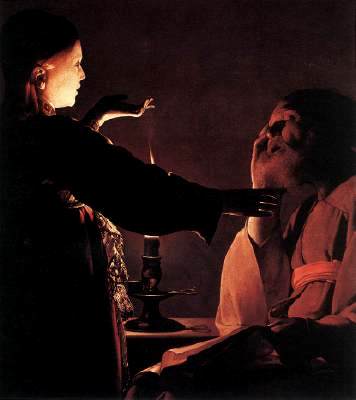 There was a more civilized alternative to death by stoning: a quiet divorce. This is what Joseph decided to do.
There was a more civilized alternative to death by stoning: a quiet divorce. This is what Joseph decided to do.
Something now happened in the story that changed world history. Joseph had a dream, a very powerful one, in which he was guided by God to take Mary as his wife.
The text describes the message as coming from an ‘angel’, without going into details of what it meant by ‘angel’. Biblical writers seemed to have used the word as a sort of code: the message of an ‘angel’ meant that a deep conviction settled on a person that God had a particular purpose or plan, and that they were part of it. They must follow this purpose through to the end, even if it did not seem to make sense to them. They must simply trust in God.
The dream/angel told Joseph to marry Mary, even though he knew the child would not be his. This he did. Then, awed by the dream and God’s message, he decided to abstain from sexual relations with her until after the baby was born.
Read the blue text at end of page
Bethlehem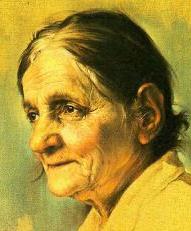
During the reign of Augustus (31BC-14AD), the Romans systematically reorganised their provinces. As part of this, they may have carried out censuses of the population for the purposes of taxation. Judea, a member state of the large Syrian province, would have been affected by this imperial decree. This could have been the reason that Mary and Joseph, who you would expect to find in Nazareth, were in Bethlehem at the time of the birth of Mary’s baby.
But there may also have been another reason, one that the gospels preferred not to mention. Nazareth was a conservative rural community, used to handling its own problems. Under such a system, honour killings were sometimes used as a means of settling disputes linked to sexual misdemeanours.
It may have been that when Mary’s pregnancy became known in the village, she was hastily sent to stay with relatives in the south for her own protection. She certainly visited Elizabethand Zechariah at this time: they lived near Jerusalem, quite a distance from Nazareth, and were of unblemished social respectability – a perfect haven for a young woman with an unexplained pregnancy.
If this was the case, it could place Mary and Joseph in or near Bethlehem at the time ofthe birth of Jesus. This is important, since it was prophesised that the Messiah would be born in the ‘city of David’. In the Old Testament, Jerusalem is the city of David, but Bethlehem is the city where David came from. Bethlehem is about 5 miles from Jerusalem and about 85 miles from Nazareth.
Read the green text at end of page
Mary bears a son
According to Matthew, it was Joseph who chose the name of the child. Names were much more important in that culture than in ours. They were meant to point to the actual character and destiny of the child, and so a great deal of thought went into selecting the right name.
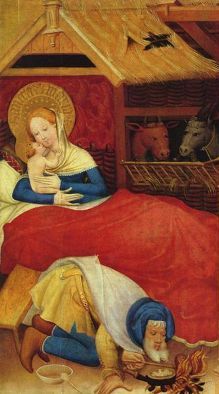
‘Jesus’ is the Greek form of the Hebrew Joshua, ‘the Lord saves’. Joshua was the heroic warrior who led the Hebrews into the Promised Land after Moses died. To the first Christians, Jesus was the prophet who would save them and lead them into a different, heavenly Promised Land.
Naming a child had an another function: it was a way of claiming a child as your own. When Joseph named Jesus, he was establishing Jesus’ Davidic lineage through his own ancestry – which makes Joseph very significant in the story of Jesus.
Mary would not have been alone when she gave birth to Jesus, as pious legend likes to picture her. Even if she was travelling and not at home, she would have been helped by a number of women, some from her own family. It was rare for a husband and wife to travel alone together, without any family members around them, and it seems most unlikely in the case of a heavily pregnant woman like Mary.
Luke’s gospel makes a point of saying that ‘there was no room for them at the inn’, so the birth probably happened in one of the storage caves hollowed out of the rock near each house. Imagine an over-crowded Palestinian peasant house: a single-roomed home with an animal stall under the same roof. Jesus was placed in one of the animals’ feeding troughs.
A question sometimes asked is: what happened to the placenta? In modern Jewish tradition, the placenta is buried as soon as possible after the birth of the child. Since the Jewish purity laws and rituals today are much the same as they were then, it is safe to assume that something similar happened at the birth of Jesus. The midwives would have taken the placenta, dug a hole outside the boundary of the village, and buried it.
No-one really knows the date that Jesus was born. The early Christian church named the shortest day of the year as his birthday: after that, each succeeding day becomes lighter and longer. The implication was that the birth of Christ brought light and life into the world.
Read the red text at end of page
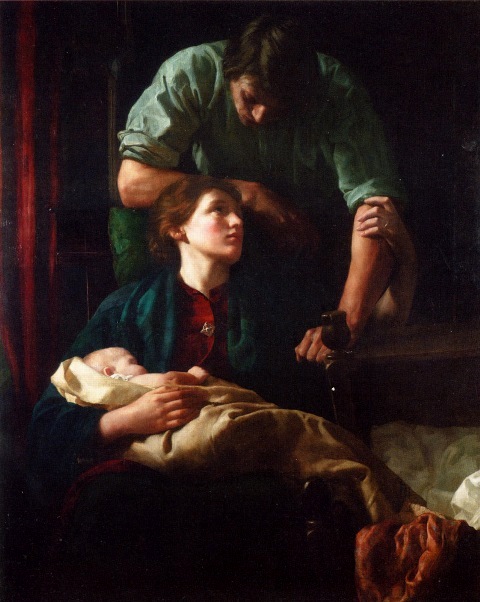 What happened next? See Shepherds and Angels
What happened next? See Shepherds and Angels
Return to top
What the Gospels say
There are two descriptions of the birth of Jesus. Matthew focuses on Joseph, Luke on Mary.
1. Joseph’s dream. Read the blue text
2. Bethlehem. Read the green text
3. Mary bears a son. Read the red text
Matthew 1:18-25 18 Now the birth of Jesus Christ took place in this way. When his mother Mary had been betrothed to Joseph, before they came together she was found to be with child of the Holy Spirit; 19and her husband Joseph, being a just man and unwilling to put her to shame, resolved to divorce her quietly. 20 But as he considered this, behold, an angel of the Lord appeared to him in a dream, saying, “Joseph, son of David, do not fear to take Mary your wife, for that which is conceived in her is of the Holy Spirit; 21 she will bear a son, and you shall call his name Jesus, for he will save his people from their sins.” 22 All this took place to fulfil what the Lord had spoken by the prophet: 23 “Behold, a virgin shall conceive and bear a son, and his name shall be called Emmanuel” (which means, God with us). 24When Joseph woke from sleep, he did as the angel of the Lord commanded him; he took his wife, 25 but knew her not until she had borne a son; and he called his name Jesus.
Luke 2:1-7 1 In those days a decree went out from Caesar Augustus that all the world should be enrolled. 2 This was the first enrolment, when Quirinius was governor of Syria. 3 And all went to be enrolled, each to his own city.
4 And Joseph also went up from Galilee, from the city of Nazareth, to Judea, to the city of David, which is called Bethlehem, because he was of the house and lineage of David, 5 to be enrolled with Mary, his betrothed, who was with child. 6 And while they were there, the time came for her to be delivered. 7And she gave birth to her first-born son and wrapped him in swaddling cloths, and laid him in a manger, because there was no place for them in the inn.
You might like to compare the parallel accounts of the births of Jesus and John the Baptist in Luke’s gospel. You can find the gospel texts at http://www.womeninthebible.net/Elizabeth_bible_text.htm
Notice especially statements about
the pregnancy reaching term, Luke 1.57 and 2.6
the birth statement, Luke 1.57 and 2.7
marvelling onlookers, Luke 1.63 and 2.18
the taking to heart of what had happened, Luke 1.66 and 2.19
circumcision and name-giving, Luke 1.59 and 2.21
John’s birth is clearly a prelude to the birth of Jesus.




